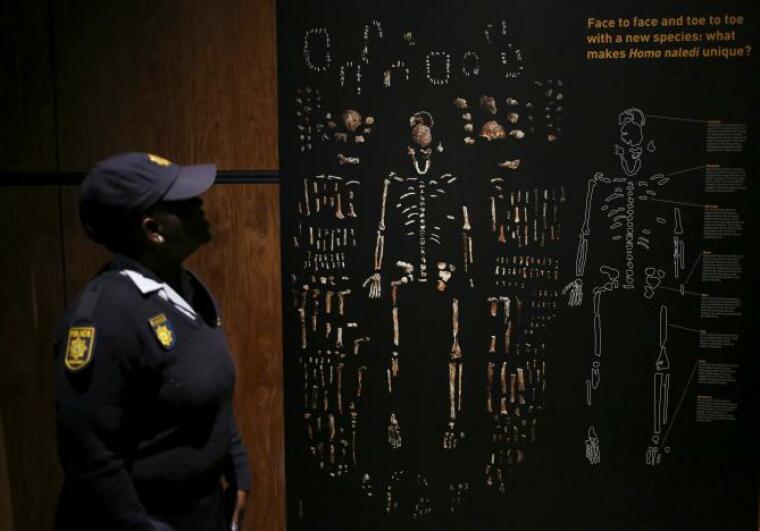Homo naledi fossils are said to be inconsistent with current evolutionary theory

The fossils that were recently discovered in South Africa have reportedly surprised academics because its dates are said to be at odds with the current evolutionary theory.
Earlier this month, a team of paleoanthropologists released three linked papers describing new fossils belonging to Homo naledi, a species said to stand about five feet tall. The species was said to have lived between 236,000 and 335,000 years ago, which is believed to be the period when early humans were just starting to evolve modern traits.
Professor Lee Berger of the University of the Witwatersrand recently announced that he and his team have discovered another chamber that contains abundant remains of Homo naledi. He believes that the remains were deliberately buried, and he asserted that Homo naledi were able to control fire and use it for illumination because the fossils were located in deep underground chambers.
A Southern Baptist paleontologist is claiming that the fossils are consistent with biblical chronology, representing a human species that were alive after the dispersion of people from the Tower of Babel as narrated in Genesis 11:1-9
Kurt Wise, professor of natural history at Truett-McConnell University and a Harvard-trained paleontologist, believes that Homo naledi were humans who descended from Adam and Eve.
He claimed that "radiometric dates" calculated by scientists to be 100,000–800,000 "radiometric years are found on fossils actually dating" more recently.
Wise, who believes that the universe was created by God approximately 6,000 years ago, argued that Homo naledi were humans "because humans are the only organisms known to cache or bury the bodies of their dead." He contended that it is highly unlikely for humans to make the e4foort to bury non humans in a cave, which he says are "almost certainly burial chambers."
He surmised that the fossils must date from after the dispersion of the people from Babel because the remains were found in South Africa, which he says is a very long way from wherever Babel was located.
Wise suggested that the human population during the time of Babel and afterward was more diverse than the human population today because the skeletal structure of Homo naledi is "markedly different from modern humans."
Jonathan Wells, a biologist at the Seattle-based Discovery Institute, which advocates the theory of Intelligent Design, contended that the evolutionary scientists' surprise at the fossils is a significant aspect of the discovery.
"Human origins are as mysterious now as they have ever been. Science educators tell materialistic stories about how we are accidental byproducts of unguided evolution, and the stories are illustrated with iconic drawings of apes morphing into humans," Wells told the Baptist Press.
"But the stories came first; fossils were plugged in later. As Yale paleoanthropologist Misia Landau once wrote, stories of human evolution 'far exceed what can be inferred from the study of fossils alone,' so fossils are placed 'into preexisting narrative structures,'" he added.
The fossils of Homo naledi were featured in the exhibit titled "Almost Human," which opened on Thursday at the Maropeng Cradle of Humankind in Johannesburg, South Africa.
 Christians don't have to affirm transgenderism, but they can’t express that view at work: tribunal
Christians don't have to affirm transgenderism, but they can’t express that view at work: tribunal Archaeology discovery: Medieval Christian prayer beads found on Holy Island
Archaeology discovery: Medieval Christian prayer beads found on Holy Island Presbyterian Church in America votes to leave National Association of Evangelicals
Presbyterian Church in America votes to leave National Association of Evangelicals Over 50 killed in 'vile and satanic' attack at Nigerian church on Pentecost Sunday
Over 50 killed in 'vile and satanic' attack at Nigerian church on Pentecost Sunday Ukrainian Orthodox Church severs ties with Moscow over Patriarch Kirill's support for Putin's war
Ukrainian Orthodox Church severs ties with Moscow over Patriarch Kirill's support for Putin's war Islamic State kills 20 Nigerian Christians as revenge for US airstrike
Islamic State kills 20 Nigerian Christians as revenge for US airstrike Man who served 33 years in prison for murder leads inmates to Christ
Man who served 33 years in prison for murder leads inmates to Christ


 Nigerian student beaten to death, body burned over ‘blasphemous’ WhatsApp message
Nigerian student beaten to death, body burned over ‘blasphemous’ WhatsApp message 'A new low': World reacts after Hong Kong arrests 90-year-old Cardinal Joseph Zen
'A new low': World reacts after Hong Kong arrests 90-year-old Cardinal Joseph Zen Iran sentences Christian man to 10 years in prison for hosting house church worship gathering
Iran sentences Christian man to 10 years in prison for hosting house church worship gathering French Guyana: Pastor shot dead, church set on fire after meeting delegation of Evangelicals
French Guyana: Pastor shot dead, church set on fire after meeting delegation of Evangelicals ‘Talking Jesus’ report finds only 6% of UK adults identify as practicing Christians
‘Talking Jesus’ report finds only 6% of UK adults identify as practicing Christians Mission Eurasia ministry center blown up in Ukraine, hundreds of Bibles destroyed: 'God will provide'
Mission Eurasia ministry center blown up in Ukraine, hundreds of Bibles destroyed: 'God will provide' Church holds service for first time after ISIS desecrated it 8 years ago
Church holds service for first time after ISIS desecrated it 8 years ago Burger King apologizes for 'offensive campaign' using Jesus' words at the Last Supper
Burger King apologizes for 'offensive campaign' using Jesus' words at the Last Supper Uganda: Muslims abduct teacher, burn him inside mosque for praying in Christ’s name
Uganda: Muslims abduct teacher, burn him inside mosque for praying in Christ’s name